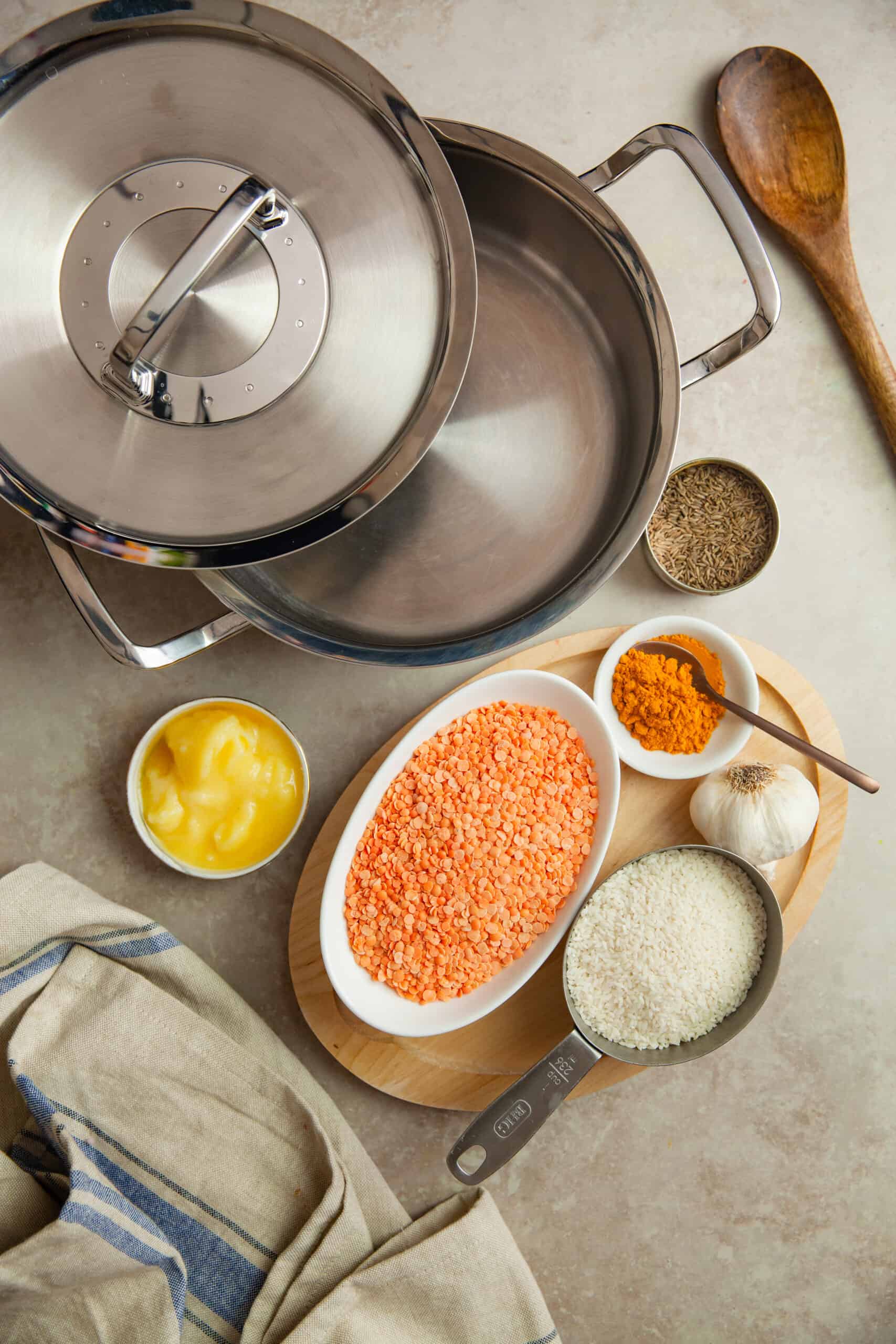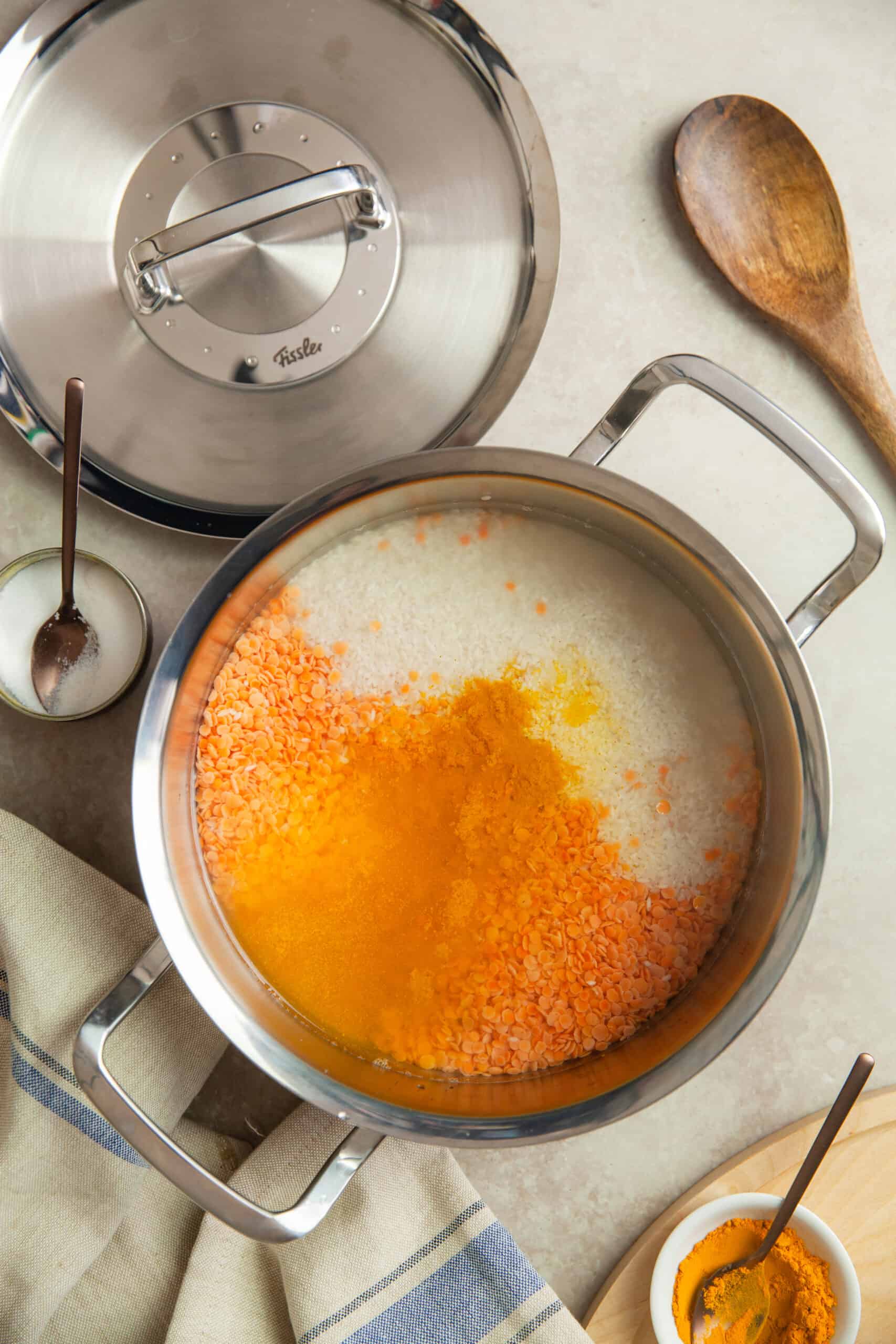Depending on how much time you want to spend, you can make khichdi either in an instant pot, pressure cooker or make it slow cooked. I go for the slow cooked version mostly because I like the consistency and the creaminess of slow cooked khichdi, however, any way you choose to make it, like most lentil & rice dishes, it is super hearty and an absolute comfort food.
What is Dal Khichdi
Every cuisine has its comfort food, and khichdi is one of the most loved comfort food for Indians. Khichdi is made by boiling rice and lentils (red lentils or mung lentils or chana/urad lentils etc) together with turmeric and salt. Sometimes few spices are added and well as depending on how different homes like it, vegetables like potatoes or peas are also added. Everything is cooked till it resembles a runny porridge and is often tempered with garlic or cumin seeds and served warm.
What are the Ingredients Needed to Make Khichdi
You need very basic ingredients from your pantry. Lets discuss them one by one :- Red Lentils :- In this recipe, I used Masoor Dal or red lentils since this was the most common type of khichdi that was made in my home. However you can easily swap the red lentils with yellow moong dal or split green moong dal. If using yellow moong dal, dry roast them slightly before using, it gives a nice flavor. Rice :- For the best consistency of the khichdi, I suggest using any starchy short grain rice. I use gobindbhog/kalijeera rice and it is easily available in Indian stores. However, my grandmother used to use tukda basmati rice which is simply broken grains of basmati rice. I don’t find it here at my indian stores but if you do, go for it. Please don’t use brown rice since its husky and takes away the smooth texture of the khichdi. Ghee :- Use ghee for cooking khichdi as well as for making the tempering. However for plant versions, you can simply use neutral oil. Spices :- While the khichdi cooks, I spice it simply with minced ginger, hing, turmeric powder and black peppercorns. Before serving, I make a tempering of garlic, cumin and red chili powder (optional). You can also use bay leaf, cloves or cardamom to add more flavor.
How To Make Dal Khichdi
Slow Cooking Method
Start by simply tempering and then boiling the lentils and rice together to a heavy bottom pot. Once boiling, reduce the heat to low and cook covered for 25-30 minutes or longer depending on how long it takes for grains to cook. Keep stirring often, it makes the khichdi creamy by breaking down the starches of the lentils and rice.
Instant Pot or Pressure Cooker Method
Temper and add the lentils and rice to the IP or Pressure cooker with 3 times the water to begin with. Close the lid and pressure cook. For the quantities mentioned in the recipe, on medium heat, it takes about 8 minutes in an Instant pot and 3-4 whistles in a pressure cooker. Let pressure release naturally in both cases, add more water an cook a little to adjust the desired consistency and then proceed to adding tempering.
Serving Khichdi
In most homes, khichdi is served with pickle, papadums, and slightly tart yogurt. In Bengali cuisine, then serve it with omelete and fried potatoes or vegetables (bhaja). You can also make a simple potato curry and serve alongside. Green chutney or a quick kachumber salad also pairs quite well.
Variations
Masala Khichdi :- Saute ⅓ cup of chopped onions with the ginger and add ½ teaspoon coriander powder and ¼ teaspoon red chili powder (or to taste). Vegetable Khichdi :- Add 1 to 1.5 cups of mixed vegetables to make vegetable khichdi. Spinach Khichdi :- Add ½ cup of finely chopped or torn spinach while the khichdi is boiling.
Recipe Tips
Always start with a optimum quantity of water at the beginning as noted in the recipe. Later as needed or depending on the consistency you desire, add warm water and mash the khichdi. Don’t add too many spices. Khichdi should taste of lentils and rice and its supposed to be a mellow dish. You can add 1-2 chopped green chilies to the tempering that goes on top if you like to add a little heat to khichdi. You may add a little bit of black pepper powder instead of whole peppercorns. Black pepper helps the body in absorption of turmeric.




